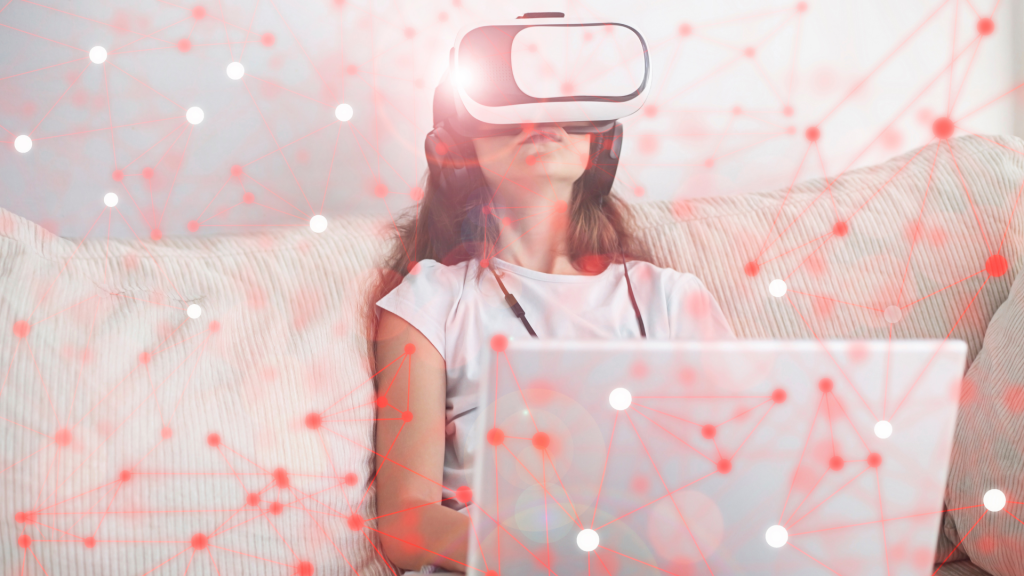Education is a dynamic sector, and with advancing technology, significant changes in teaching and learning methods are observed. Among the most revolutionary innovations are Virtual Reality (VR) and Augmented Reality (AR) in project-based learning. These technologies are transforming educational practices and providing new, effective strategies to enhance learning. This paper aims to explore the application of VR and AR in education, focusing on their benefits, examples, and potential future developments.
What is Virtual Reality (VR) and Augmented Reality (AR)?

A child deeply immersed in Virtual Reality learning. Image by Canva.
Virtual Reality (VR) provides users with a realistic simulation of an environment through three-dimensional representations using headsets and other instruments. Augmented Reality (AR), on the other hand, overlays digital information onto the real world using smartphones, tablets, and sometimes AR glasses, blending the physical and virtual worlds seamlessly.
Benefits of VR and AR in Education
Enhanced Engagement and Motivation

Here is a young learner achieving high engagement and motivation to learn about the space with Virtual Reality (VR) and Augmented Reality (AR) in Project-Based Learning. Image by Canva.
Virtual Reality (VR) and Augmented Reality (AR) in project-based learning can significantly boost student engagement by making learning interactive and enjoyable. These technologies capture students’ attention, motivating them to participate actively in their lessons. For example, VR enables students to take virtual field trips to places they might never visit in person, such as ancient ruins, outer space, or the ocean floor, making subjects like history and science more relatable and exciting.
Deeper Understanding and Improved Retention

A young learner gains a deeper understanding and improved retention of the lessons taught with VR and AR. Image by Canva.
Research shows that students retain information better when they can visualize and interact with the material. VR and AR provide multisensory experiences that cater to different learning styles, helping students grasp complex concepts more easily. For instance, AR can bring abstract mathematical problems to life, allowing students to manipulate and explore them tangibly. Interactive simulations in VR can recreate lab experiments, enabling students to conduct virtual experiments safely and repeatedly.
Real-World Applications and Skill Development

A learner gets a more realistic hands-on experience in the lesson. Image by Canva.
VR and AR bridge the gap between theoretical knowledge and real-world applications. Medical students can practice surgeries in a risk-free virtual environment, while engineering students can assemble and test machinery before working with physical prototypes. These hands-on experiences prepare students for real-life challenges, enhancing their practical skills and confidence. In language learning, VR and AR can immerse students in virtual environments where they can practice speaking and listening skills with native speakers, providing effective and engaging contextual learning opportunities.
Personalized Learning

VR and AR can adapt to a young learner’s progress, offering instant feedback and adjusting difficulty levels as needed. Image by Canva.
These technologies allow for personalized learning experiences tailored to individual needs and pace. VR and AR can adapt to the user’s progress, providing instant feedback and adjusting difficulty levels accordingly. This customization ensures that students receive the right level of challenge and support, promoting a more effective and individualized learning process. For example, in special education, VR can create calming environments for students with autism, while AR can provide step-by-step visual instructions for students with learning disabilities, aiding comprehension and independence.
Future Trends in VR and AR in Education
The application of VR and AR in education is expected to grow significantly as technology advances. With the increased availability of these tools and reduced costs, it will be possible to integrate them into mainstream education. Future trends may include enhanced skills through realistic simulations, virtual classrooms that combine real and virtual classes, and the incorporation of artificial intelligence for more personalized learning. These advancements hold the potential to make education more effective and enjoyable, heralding a bright and innovative future for learners.
The future of education with VR and AR is promising, and filled with exciting innovations that can revolutionize learning. To young learners: embrace these technologies to enhance your educational experiences, but do so ethically. Use VR and AR to explore new possibilities, deepen your understanding, and develop practical skills. By doing so, you can maximize the benefits of these groundbreaking tools and prepare for a future where learning is more interactive, engaging, and effective.

